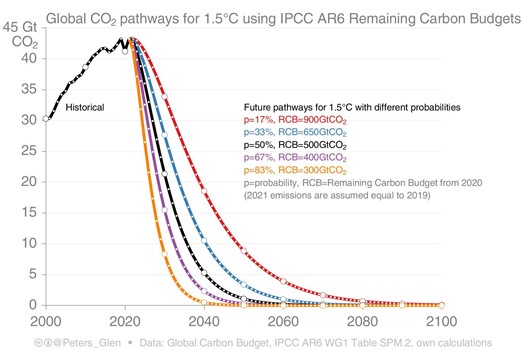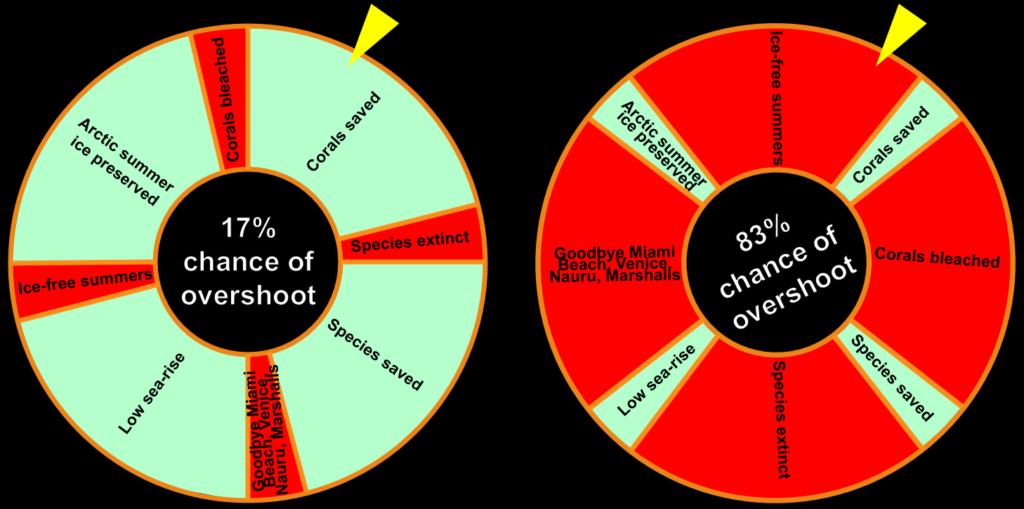
Of Carbon Budgets and Roulette Wheels
By: Chandu Visweswariah
The recent United Nations IPCC (Intergovernmental Panel on Climate Change) 6th Assessment Report has set off a frenzy of “after-market analysis” in the environmental community to help the public make sense of the scientific jargon in the report. There is no ambiguity that we must reduce emissions to a level that can be absorbed by natural systems; if greenhouse gases continue to increase in the atmosphere, the earth’s climate systems will get perilously unstable. The buzz is about what happens if we do not reduce emissions fast enough – in other words, what are the probabilities of various climate calamities under different decarbonization pathways? Glen Peters, Research Director at the Center for International Climate Research in Oslo, published the above graphic.
Each line in the graphic represents a future emissions scenario. Let’s look at the red line. In that scenario, CO2 emissions fall starting in 2021, reach 50% reduction by about 2040 and net zero by about 2080. In this scenario, what is the total carbon budget since the start of 2020? Answer: 900 Gigatons of CO2 (a gigaton is a billion tons) – that’s the cumulative emissions from 2020 to the end of the century. And is it possible that we will restrict global warming to 1.5oC under this scenario? Answer: yes, but with a paltry probability of 17% and therefore unlikely. In other words, we take an 83% risk of exceeding 1.5oC of warming and being exposed to the concomitant environmental risks.
Now turn your eye to the orange line. It aggressively reduces CO2 much faster: 50% reduction by 2030 and net zero by 2040, in line with CURE100 goals. Accordingly, the carbon budget is only 300 Gigatons of CO2, 1/3 of the red line that we looked at. And what is the probability of keeping warming within 1.5oC? A good answer: 83% and therefore highly likely.
As Greta Thunberg tweeted, “This basically sums up our situation.”
Either we aggressively decarbonize and achieve a high probability of keeping warming at manageable levels, or we decarbonize at a more sedate pace — the business-as-usual approach — but take much higher environmental risks.
What does all this have to do with roulette wheels?

We are basically playing a high-stakes game of roulette (see cartoon illustration above) with our planet at stake – a game I call the “Wheel of Misfortune.” Imagine a wheel with better and worse outcomes painted on it that we spin 10 times to determine whether low-lying lands are lost to rising oceans, species are eliminated, or glaciers disappear. Rapid decarbonization gives us a “conducive” wheel where the odds are stacked in our favor, while sedate decarbonization stacks the odds against us. Which wheel would you rather have future generations inherit from us?
One final point: is it possible even in the most aggressive decarbonization scenario that we will exceed 1.5oC of warming? Yes, it is possible. However, the chances are much lower and the amount of “overshoot” (i.e., amount by which we exceed 1.5oC) relatively small.
What more do we need to know? Although the subject matter is complex, the scientists have been crystal clear and now it is up to all of us. We get to choose which roulette wheel we spin: the predominantly green one or the predominantly red one. Time to stop debating and start acting!
[Postscript: For those who want to know more about the data supporting these predictions, the IPCC uses a tool called TCRE (Transient Climate Response to Cumulative CO2 Emissions) to predict warming under various emissions scenarios. To trace the full lineage of this information, you need to look at Table 5.8 on page 5-96 of the full report, which in turn is summarized (more understandably) in Table 5.3 on page TS-63 of the Technical Summary, which in turn is summarized (yet more understandably) in Table SPM.2 on page SPM-38 of the Summary of Policy Makers.]
2 thoughts on “Of Carbon Budgets and Roulette Wheels”
Leave a Reply to Eleanor Kwei Cancel reply
You must be logged in to post a comment.


Wheel of Misfortune!! Laugh and cry…
Ok, won’t be crying.
The Chinese describe indifference: “Watching a city in flames from the opposite river bank”
Re: Mary’s comment and your reply from the previous post: how to emphasize the urgency? The fire is not across the river…
If local community members are indifferent or head in the sand… you are reaching other communities who WILL listen. There is hope as long as there are groups like Croton 100…
Wheel of Misfortune!! Laugh and cry…
Ok, won’t be crying.